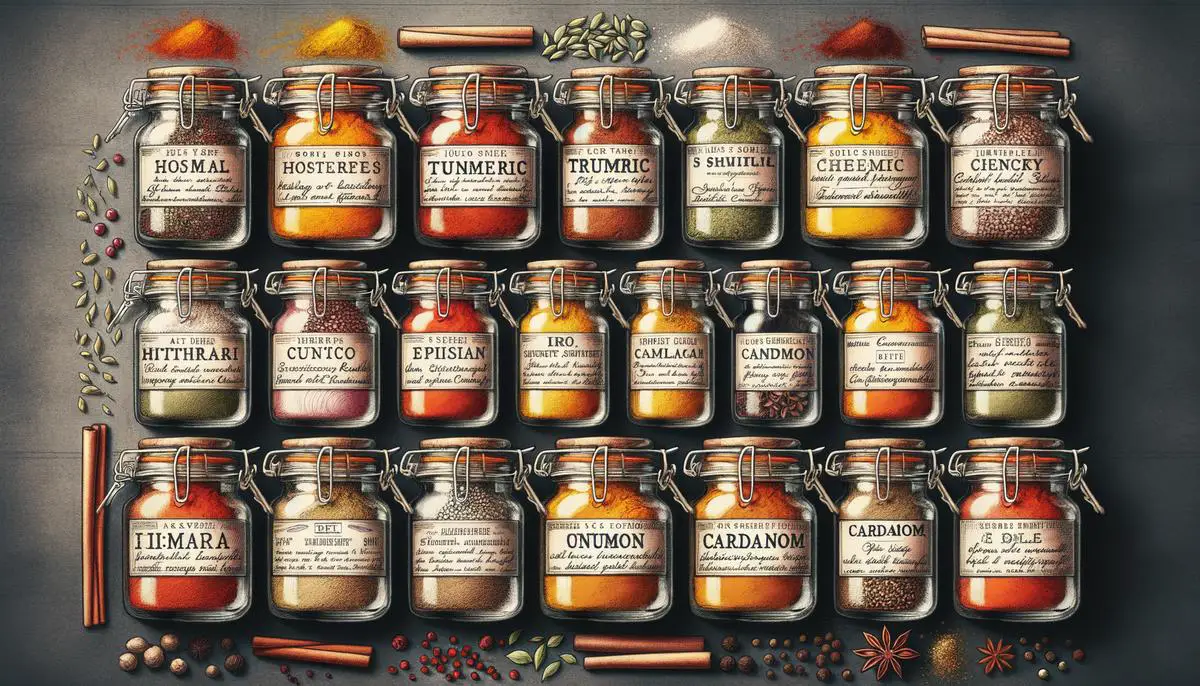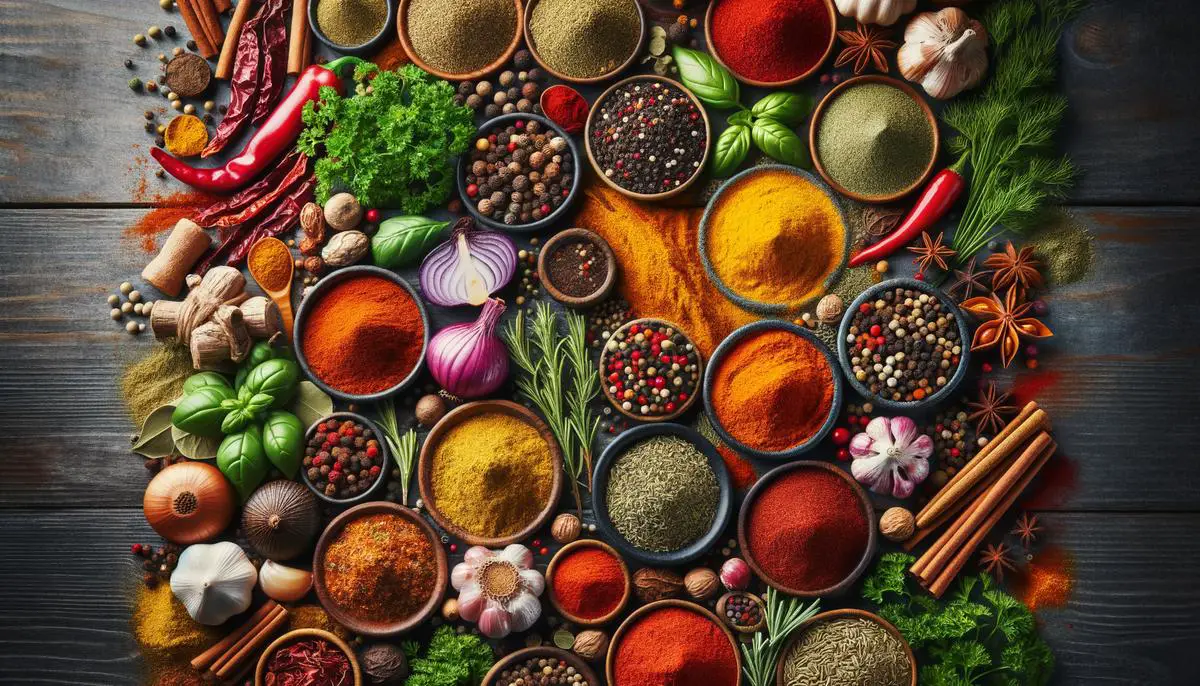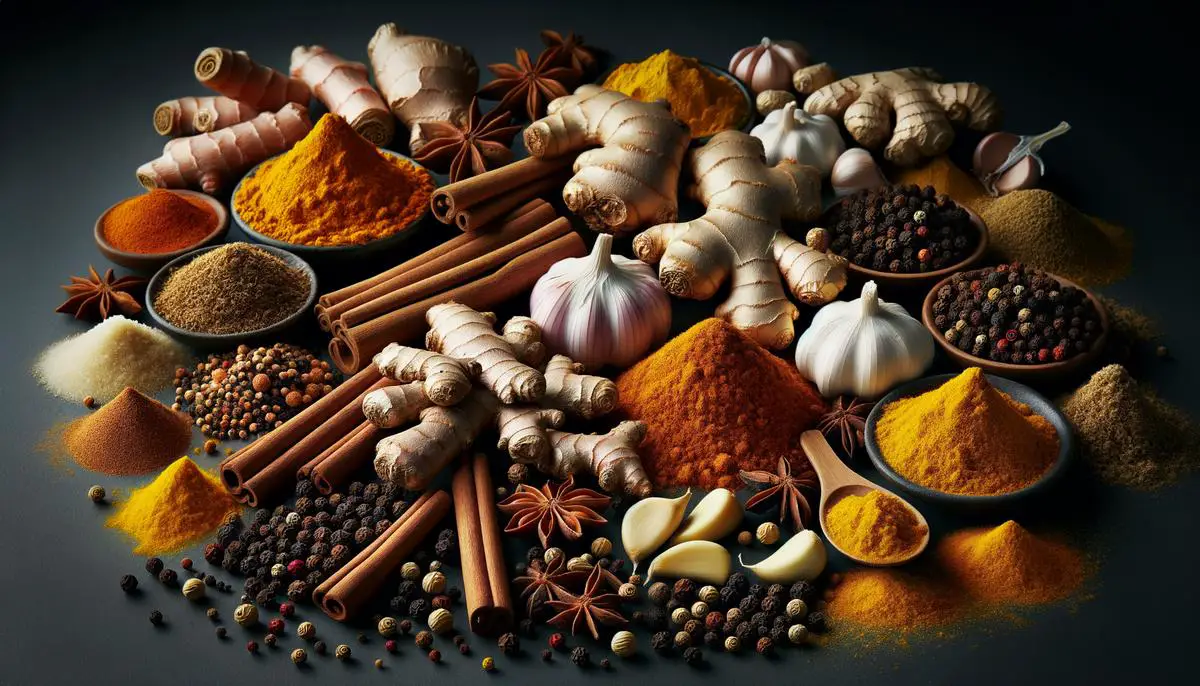
Spices hold a unique position in the tapestry of nutrition, acting not just as ingredients that add depth and flavor to our meals but as elements rich in health benefits. This exploration seeks to illuminate the various ways in which these aromatic elements contribute to our well-being, underscoring their value beyond the kitchen.
The Nutritional Profile of Common Spices
Spices – Nature’s Flavorful Nutritional Powerhouses
In the vast mosaic of nutrition and wellness, spices emerge not just as enhancers of culinary art but as significant contributors to our nutritional intake. Often overshadowed by their roles in seasoning our meals, the truth beckons a deeper exploration into how these aromatic wonders impact our health.
Unlocking the Nutritional Secrets of Spices
At the heart of every kitchen lies a treasure trove of spices, each bearing unique flavors and a plethora of nutritional benefits. From the warm embrace of cinnamon in a morning latte to the invigorating kick of chili in a stew, spices do more than just titillate our taste buds – they infuse our meals with indispensable nutrients and bioactive compounds.
The Quintessence of Antioxidants
Antioxidants are the body’s guardians, protecting our cells from damage caused by free radicals. Spices are remarkably high in these compounds, offering an arsenal of protection with every sprinkle. For instance, turmeric, with its vibrant golden hue, is not just a staple in curries but a powerhouse of curcumin, an antioxidant known for its anti-inflammatory properties and potential to enhance brain health.
A Symphony of Minerals and Vitamins
Beyond their antioxidant prowess, spices are also miniature storehouses of vitamins and minerals essential for maintaining our bodies’ intricate systems. Cinnamon, for example, is not only a conduit of warmth in flavor but also a source of manganese, essential for bone health and metabolic function. Similarly, sumac, less known but equally potent, boasts high levels of Vitamin C, fortifying the immune system and skin health.
Metabolic Wizards
The influence of spices extends into the realm of metabolism, where they play pivotal roles in regulating blood sugar levels and enhancing digestive health. Fenugreek, with its earthy tones, has shown promise in moderating blood sugar, making it a valuable ally for those navigating diabetes. Additionally, the fiery capsicum found in chili peppers ignites metabolic rates, fueling the body’s fat-burning capabilities.
The Alchemy of Spices in Daily Nutrition
Incorporating spices into our diet is both an art and a science. A dash of black pepper not only elevates the flavor profile of a dish but also enhances the absorption of turmeric’s nutrients, exemplifying the symbiotic relationships within the spice world. Similarly, integrating ginger into meals or teas can soothe digestive woes, showcasing how culinary practices intertwine with health.
In Conclusion
The realm of spices is a testament to nature’s generosity, offering a cornucopia of flavors and health benefits. These dietary magicians do more than just contribute to our nutritional intake; they weave wellness into the very fabric of our meals. As we savor the flavors spices bring to our plates, let us also embrace the profound, often hidden, nutritional gifts they offer. In the alchemy of cooking, spices are not mere ingredients but vital companions on our journey to wellness, each spoonful a step towards a healthier, more vibrant life.

Health Benefits and Scientific Evidence
Venturing deeper into the realms of health and science, the exploration of spices unveils a fascinating fusion of culinary tradition and medicinal potential. Far beyond their ability to elevate a dish from mundane to extraordinary, spices serve as a cornerstone in the edifice of traditional and modern medicine. This journey into the scientific evidence supporting the health benefits of spices reveals a narrative rich in history, culture, and science.
Turmeric, a vibrant yellow spice, often steals the limelight in discussions about health-centric spices, primarily due to curcumin, its active compound. Research delineates curcumin’s role in reducing inflammation, a common villain in chronic conditions like arthritis and heart disease. The breadth of studies points toward curcumin’s ability to moderate the body’s inflammatory processes, offering a promise of relief and a beacon of hope for those battling chronic inflammation.
Cinnamon, with its warm and comforting fragrance, is another spice that harbors secrets well-respected in scientific circles. Among the myriad of benefits, its influence on blood sugar levels is particularly noteworthy. Clinical trials suggest that compounds in cinnamon can mimic insulin, the vital hormone responsible for lowering blood sugar levels. This spice’s ability to improve insulin sensitivity could be a game-changer in managing diabetes and preventing its onset.
Ginger, with its bold and zesty character, brings to the table not just flavor but also a wealth of health benefits. Known for its soothing effect on the digestive system, ginger’s prowess extends to mitigating nausea and vomiting. The evidence is particularly compelling in the context of pregnancy-induced morning sickness, where ginger stands out as a natural remedy embraced by both traditional practitioners and contemporary researchers.
Garlic, despite its pungent aroma, enjoys universal acclaim for its cardiovascular benefits. The sulfur compounds, which give garlic its characteristic smell, are also responsible for its ability to combat heart disease risk factors. Clinical studies highlight garlic’s role in lowering blood pressure and cholesterol levels, underscoring its importance in a heart-healthy diet.
Cloves, though used sparingly due to their potent flavor, emerge as potent allies in the battle against oral diseases. Eugeonol, the main component, exhibits remarkable antiseptic properties, making cloves an effective remedy for dental pain, gum diseases, and infections. The intersection of dentistry and spice-based remedies exemplifies the holistic approach to wellness that spices embody.
Pepper, often dubbed as the “King of Spices,” offers more than just a spicy kick. The compound piperine, responsible for its pungency, is shown to enhance the absorption of essential nutrients like selenium, vitamin B, and beta-carotene. This attribute of black pepper amplifies the nutritional value of meals, ensuring the body reaps the maximum benefit from consumed foods.
In the realm of spices, the convergence of taste and health is a testimony to nature’s brilliance. The scientific evidence supporting the health benefits of spices paints a picture of a medical treasure trove, waiting to be harnessed to its full potential. Each spice, with its unique compounds and effects, contributes to the narrative of spices not just as culinary agents but as pillars of health and wellness. The tapestry of research and tradition woven around spices is not just about adding flavor to our plates but about enriching the quality of our lives, one sprinkle at a time.

Potential Risks and Considerations
Beyond the garnish of vibrant hues and the dance of flavors they introduce, spices bring complexity not only to our plates but to our wellness narratives. However, the world of spices, much like a tapestry, weaves in threads of caution along with its vibrant yarns of health benefits. Engaging with spices requires an understanding of their dual nature. While they are celebrated for their health-promoting properties, certain contexts and conditions highlight potential risks associated with their consumption. Let’s delve into the less-discussed side of spices, offering a balanced perspective on this ancient cornerstone of holistic health.
The Allergy Conundrum
Spices can be covert operatives in the world of food allergies, often slipping under the radar due to their minimal presence in dishes. Yet, for some individuals, even trace amounts can trigger allergic reactions ranging from mild to severe. Unlike the common culprits of food allergies—nuts, dairy, and shellfish—spices can be harder to identify and avoid, given their widespread use and sometimes hidden presence in food products.
Digestive Dilemmas
For all the digestive aid some spices can boast, they can play the foil for those with sensitive stomachs or conditions such as irritable bowel syndrome (IBS) or acid reflux. Spices such as chili can exacerbate symptoms of heartburn and indigestion, turning a meal into an uncomfortable experience. The heat and intensity that some people crave in spicy food can thus become a source of distress for others, underscoring the importance of personalized nutrition.
Interactions with Medications
The potent properties of spices don’t end on the palate; they extend into our metabolic pathways, sometimes interacting with medications in ways that can dilute or amplify the drug’s intended effects. For instance, turmeric, hailed for its anti-inflammatory prowess, can interfere with blood thinners, increasing the risk of bleeding. Similarly, cinnamon, while beneficial for blood sugar control, might necessitate adjustments in diabetes medication to prevent hypoglycemia. It’s a poignant reminder of the biochemical dance happening beneath the surface when we marry natural remedies with pharmaceutical ones.
Quantity Quandaries
In the realm of spices, the adage of “too much of a good thing” finds its truth. The key to harnessing the benefits of spices without inviting adverse effects lies in moderation. High concentrations of certain spices can lead to not just acute issues such as nausea or dizziness but also long-term health concerns. For instance, excessive consumption of licorice (often found in teas and candies as well as in its raw form) can lead to hypertension, potassium depletion, and even heart issues.
Purity and Source Concerns
The journey of spices from farm to table is fraught with potential contamination—pesticides, heavy metals, and adulterants can all taint the purity of spices. The global spice trade, while enriching our pantries with international flavors, also complicates the traceability of these products. Consumers are often left reliant on brands and regulatory bodies to ensure the spices they consume are free from harmful substances. Opting for organic and reputable sources can mitigate some of these risks, but awareness and vigilance remain key.
The Bottom Line
As we weave the aromatic magic of spices into our daily nourishment, acknowledging these potential risks equips us to make informed choices for our health. Spices, in their essence, embody the philosophy of balance—a sprinkle can transform a meal and, when mindfully used, contribute to our well-being. Like any ingredient in the recipe of health, spices serve best when harmonized with the individual needs and conditions of each person, reminding us of the beauty of moderation and the wisdom of personalized nutrition.

In weaving the essence of spices into our diets, we do more than just enhance the taste of our food; we imbue our meals with elements that support our health in multiple dimensions. Spices, with their rich array of benefits and potential considerations, remind us of the importance of balance and mindful consumption. They are more than just culinary enhancements; they are a testament to the complexity and richness of nature’s bounty, offering a simple yet profound way to enrich our health one pinch at a time.



